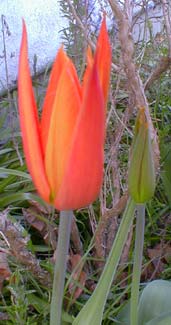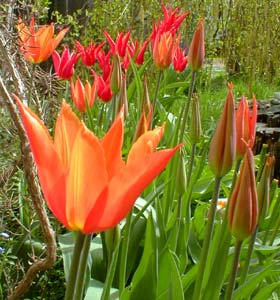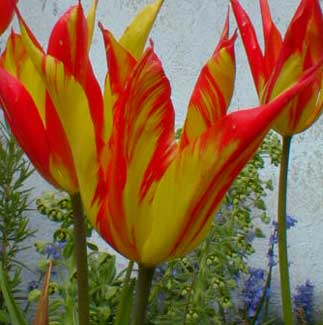
'Ballerina'
Lily-flowering Tulip
"Guarded within the old red wall's embrace,
Marshalled like soldiers in gay company,
The tulips stand arrayed. Here infantry
Wheels out into the sunlight."
-Amy Lowell,
A Tulip Garden
A Tulip Garden
Tulipa retroflexa 'Ballerina' is a tallish Lily-flowering tulip. The stem & flower reach sixteen to twenty inches, give or take, twice the height of some varieties.
It was introduced to gardening in 1980, having in its hybrid heritage T. retroflexa (1902), a bright orange tulip itself said to be of garden origin & originally grouped with Cottage Tulips.
The other great pointy-petalled tulips are the waterlily-types, otherwise known as Kaufmannianas, & we've originally planted 'Ballerina' behind the shorter T. kaufmanniana 'Heart's Delight.' 'Heart's Delight' reproduced its bulbs rather swiftly & had to be lifted in two years, & were moved elsewhere. But the lily-flowering tulips perennialize without naturalizing, so there is no need to lift them to divide bulbs, & they can remain in their location indefinitely.
 'Ballerina' flowers all of April & into May, though the first two photos here were taken in the last week in March. In the background of the second photo is a second much redder lily-flowering tulip, namely 'Alladin.'
'Ballerina' flowers all of April & into May, though the first two photos here were taken in the last week in March. In the background of the second photo is a second much redder lily-flowering tulip, namely 'Alladin.''Ballerina' has stunning flowers with a mild fragrance, a rarity among tulips such as are rarely perfumed. The bottom interior of the flowers is a startling tangerine to marigold-orange; the exterior is reddish orange aging to deeper coppery red. The shape & color lend it a flame-like blazing appearance.
In its second year in the garden 'Ballerina' showed more "twist" to the petals, plus it developed bright pure yellow on the outer petals. It had changed so much so that it scarsely looked like the orange & coppery flower it had been its first year. A comparison of the second photo (2004) & the third photo (2005) more than adequately conveys the change most of the 'Ballerinas' experienced, though a couple of them were the same duo-tone orange they had been the first year.
Also, while only a couple of 'Alladin' returned for a second year, nearly all the 'Ballerina' returned, a very reliable cultivar.
Given a hot dry spot in full sun, 'Ballerina' will perennialize for many years, but in damp locations will have to be replanted every couple years as one by one they rot out of the garden during winters' dormancy, & cannot self-seed because they are not species tulips. Ours are somewhat sheltered by the eaves of the house, but only time will tell if they stay dry enough in winter to persist for many more springs.
 The European imposition of the idea that a tulip might look like a 'Ballerina' is not terribly far off the medieval symbolism of Sufi poets who made a connection between tulips & Laila the most famously beautiful courtesan of history, whose pure & innocent love for Murad has become the material of legend.
The European imposition of the idea that a tulip might look like a 'Ballerina' is not terribly far off the medieval symbolism of Sufi poets who made a connection between tulips & Laila the most famously beautiful courtesan of history, whose pure & innocent love for Murad has become the material of legend.Because this sacredness is like a fire, lily-flowering tulips appear in sacred art as indicative of Laila's love for Murad, like unto Allah's love for humanity.
Allah may be imperceptible except in his works, but mystics sometimes glimpse a little part of His presence, which manifests with a Peri-face, that is to say, with the face of a delightful fairy princess, inspiring a pure, spiritual, intensely ecstatic & wholehearted mutual love. The Moon itself is said to be the Peri-face of God.
The Persian word for Tulip is Lalah, which not only puns rather easily with Laila, but has the same numerical value as the name of Allah. Westerners who have it hard enough just to bare in mind that Islam does not connote crazy terrorists, but a deeply spiritual faith & culture of considerable sophistication, will be further startled that this Goddess-like form of Allah exists within Sufism, & certainly there are Muslims other than Sufi this offends. But it is not unique to Sufism by any means, for the idea of God as a divine wife to Humanity is universal among mystics of many faiths.
Lailah the Courtesan or Lalah the Tulip thus become names of the Soul which is of God our last most perfect lover. Legends of Laila the Courtesan & Murad therefore do not merely regard the Sufi Romeo & Juliette, but are Eros & Psyche, Moses & the Divine Shekhinah, the divine bride of the ecstatic & nearly erotic poetry of St. John of the Cross, or a Sufi quester who glimpses that Peri-face of God.
Such is the meaning & the nature of the tulips in all gardens everywhere in the world.